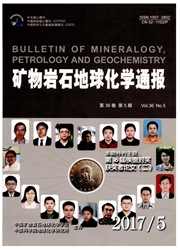

 中文摘要:
中文摘要:
总结了在岩浆-热液体系中:不同条件下,Mo在矿物、熔体、卤水溶液、蒸汽这些相之间的分配行为,以及影响因素;Mo主要以+6价迁移,无论是在热液还是硅酸盐岩浆中,钼酸根离子及其化合物都是其主要的迁移形式,而在高盐度热液中,Mo可大量的以MoO2Cl2-nn(1≤n≤2)的形式迁移;气相迁移对于Mo成矿十分重要,可在低lgfHCl(〈-1)和高lgfHCl(〉-1)的条件下分别以MoO3·n H2O(g)和MoO2Cl2(g)2种气态方式来迁移,这为斑岩型Mo矿中,钼矿化赋存部位分布在绢云母化带或钾化带的差异提供了一种新的解释;盐度、温度和压力下降,pH值升高,fO2下降而fS2上升,都可以导致Mo迁移的络合物分解,与S结合形成Mo S2并沉淀下来,围岩蚀变、流体沸腾和混合作用,能高效地富集金属,是Mo沉淀的重要机制。
 英文摘要:
英文摘要:
Summarizing that in the magmatic-hydrothermal system: The partition behaviors of Mo among minerals,melts,solution and vapour phases under different conditions and its influenced factors; Mo migrates mainly in the form of complex ion with valence of +6. Molybdate ion and related compounds are the main migrating forms no matter in silicate melt or hydrotherm. While Mo can heavily transport in MoO2Cl2-nn(1≤n≤2) in high salinity hydrotherm; vapour-phase transport of Mo is important for formation of molybdenum deposits,Mo may transport in the gaseous form of MoO3·n H2O(g) and MoO2Cl(g) in low(〈-1) and high(〉-1) value of logf conditions respectively. Which provide a new explanation for the differences of distribution of molybdenite in sericitic or potassic alteration assemblages in porphyry Mo deposits; The Mo complexes in migration will decompose resulting in the precipitation of Mo S2 when Salinity,temperature and pressure decreased,pH value elevated,fO2 value decreased and fS2 value increased. Wall rock alteration,fluid boiling and mixing are the important mechanisms for precipitation of Mo and can enrich metals efficiently.
 同期刊论文项目
同期刊论文项目
 同项目期刊论文
同项目期刊论文
 期刊信息
期刊信息
